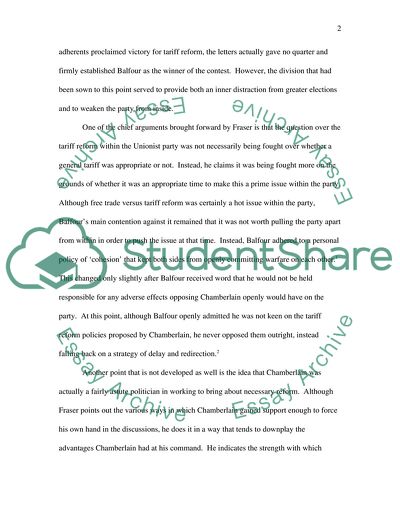Cite this document
(“Article Analysis: The Edwardian Crisis - P Fraser, 'Unionism and Essay”, n.d.)
Article Analysis: The Edwardian Crisis - P Fraser, 'Unionism and Essay. Retrieved from https://studentshare.org/miscellaneous/1536255-article-analysis-the-edwardian-crisis-p-fraser-unionism-and-tariff-reform-the-crisis-of-1906-historical-journal-5-1962-s-h-zebel-joseph-chaberlai
Article Analysis: The Edwardian Crisis - P Fraser, 'Unionism and Essay. Retrieved from https://studentshare.org/miscellaneous/1536255-article-analysis-the-edwardian-crisis-p-fraser-unionism-and-tariff-reform-the-crisis-of-1906-historical-journal-5-1962-s-h-zebel-joseph-chaberlai
(Article Analysis: The Edwardian Crisis - P Fraser, 'Unionism and Essay)
Article Analysis: The Edwardian Crisis - P Fraser, 'Unionism and Essay. https://studentshare.org/miscellaneous/1536255-article-analysis-the-edwardian-crisis-p-fraser-unionism-and-tariff-reform-the-crisis-of-1906-historical-journal-5-1962-s-h-zebel-joseph-chaberlai.
Article Analysis: The Edwardian Crisis - P Fraser, 'Unionism and Essay. https://studentshare.org/miscellaneous/1536255-article-analysis-the-edwardian-crisis-p-fraser-unionism-and-tariff-reform-the-crisis-of-1906-historical-journal-5-1962-s-h-zebel-joseph-chaberlai.
“Article Analysis: The Edwardian Crisis - P Fraser, 'Unionism and Essay”, n.d. https://studentshare.org/miscellaneous/1536255-article-analysis-the-edwardian-crisis-p-fraser-unionism-and-tariff-reform-the-crisis-of-1906-historical-journal-5-1962-s-h-zebel-joseph-chaberlai.


